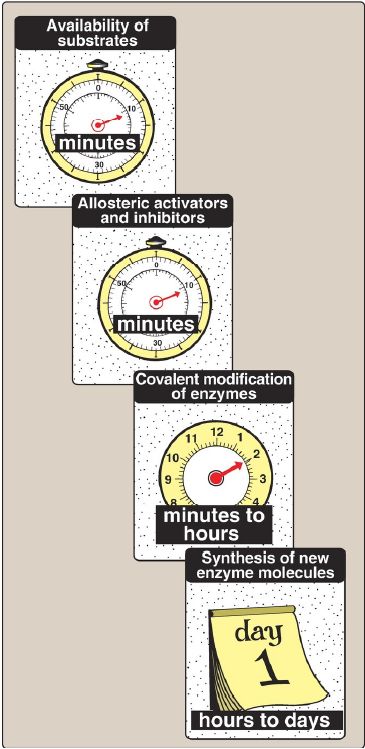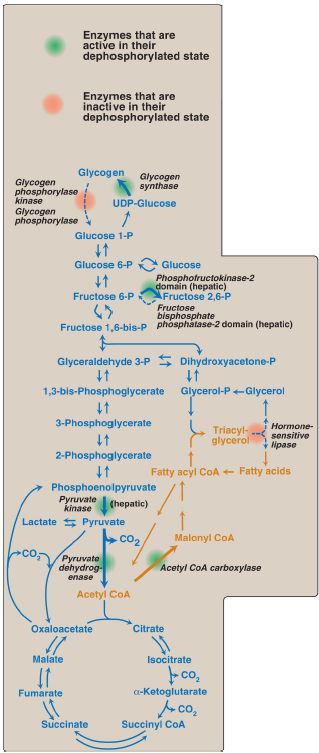
Regulatory Mechanisms of Metabolism
 المؤلف:
Denise R. Ferrier
المؤلف:
Denise R. Ferrier
 المصدر:
Lippincott Illustrated Reviews: Biochemistry
المصدر:
Lippincott Illustrated Reviews: Biochemistry
 الجزء والصفحة:
الجزء والصفحة:
 24-11-2021
24-11-2021
 1616
1616
Regulatory Mechanisms of Metabolism
The flow of intermediates through metabolic pathways is controlled by four mechanisms: 1) the availability of substrates, 2) allosteric regulation of enzymes, 3) covalent modification of enzymes, and 4) induction-repression of enzyme synthesis, primarily through regulation of transcription. Although this scheme may at first seem redundant, each mechanism operates on a different timescale (Fig. 1) and allows the body to adapt to a wide variety of physiologic situations. In the absorptive state, these regulatory mechanisms insure that available nutrients are captured as glycogen, TAG, and protein.

Figure 1 : Control mechanisms of metabolism and some typical response times. [Note: Response times may vary according to the nature of the stimulus and from tissue to tissue.]
A. Allosteric effectors
Allosteric changes usually involve rate-determining reactions. For example, glycolysis in the liver is stimulated following a meal by an increase in fructose 2,6-bisphosphate, an allosteric activator of phosphofructokinase-1 ([PFK-1] ). In contrast, gluconeogenesis is decreased by fructose 2,6-bisphosphate, an allosteric inhibitor of fructose 1,6-bisphosphatase .
B. Covalent modification
The activity of many enzymes is regulated by the addition (via kinases, such as cyclic adenosine monophosphate [cAMP ]–dependent protein kinase A [PKA] and adenosine monophosphate–activated protein kinase [AMPK]) or removal (via phosphatases) of phosphate groups from specific serine, threonine, or tyrosine residues of the protein. In the absorptive state, most of the covalently regulated enzymes are in the dephosphorylated form and are active (Fig. 24.2). Three exceptions are glycogen phosphorylase kinase , glycogen phosphorylase , and hormonesensitive lipase (HSL) , which are inactive in their dephosphorylated form. [Note: In the liver, the phosphatase domain of bifunctional phosphofructokinase-2 (PFK-2) is inactive when the protein is dephosphorylated.]

Figure 2: Important reactions of intermediary metabolism regulated by enzyme phosphorylation. Blue text = intermediates of carbohydrate metabolism; brown text = intermediates of lipid metabolism; P = phosphate; CoA = coenzyme A; CO2 = carbon dioxide.
C. Induction and repression of enzyme synthesis
Increased (induction of) or decreased (repression of) enzyme synthesis leads to changes in the number of enzyme molecules, rather than changing the activity of existing enzyme molecules. Enzymes subject to synthesis regulation are often those that are needed under specific physiologic conditions. For example, in the well-fed state, elevated insulin levels result in an increase in the synthesis of key enzymes, such as acetyl coenzyme A (CoA) carboxylase (ACC) and fatty acid synthase , involved in anabolic metabolism. In the fasted state, glucagon induces expression of phosphoenolpyruvate carboxykinase (PEPCK) of gluconeogenesis . [Note: Both hormones affect gene transcription.]
 الاكثر قراءة في الكيمياء الحيوية
الاكثر قراءة في الكيمياء الحيوية
 اخر الاخبار
اخر الاخبار
اخبار العتبة العباسية المقدسة


